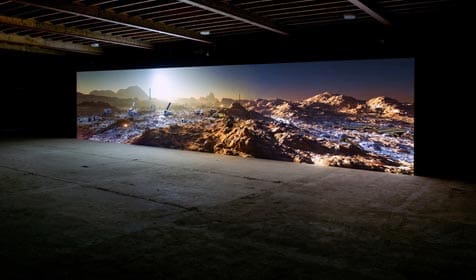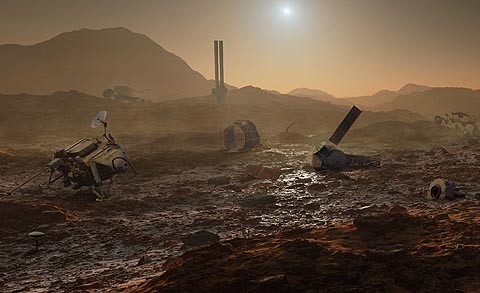

Kelly Richardson’s “Mariner 9” Animates Futuristic Mars Landscape

How might Mars look like a hundred years in the future, after we’ve sent dozens of rovers to explore the planet? That’s the idea that Canadian digital media artist Kelly Richardson wanted to explore in her new animated video installation Mariner 9. The piece debuted earlier this month at the Spanish City in Whitley Bay, UK, and will have its North American premiere at next month’s Toronto International Film Fesitval as part of their Future Projections exhibit.
The 20-minute piece is projected on a panoramic 39-foot screen. In the words of the artist, “Mariner 9”
presents a panoramic view of a Martian landscape set hundreds of years into the future, littered with the rusting remains from various missions to the planet. Despite its suggested abandoned state, several of the spacecraft continue to partially function, to do their intended jobs, to ultimately find signs of life, possibly transmitting the data back to no one.
In interviews, Richardson said that she referenced data and imagery from NASA missions to help recreate the topography of her speculative future, but the goal of this research wasn’t so much strict accuracy as authencity. She modeled and animated the landscape with Terragen software, and used Lightwave to create the vehicles.
I can only imagine that the subtle movements across a large screen would look striking, but the sheer scale of Mariner 9 demands that it be viewed in person before passing any judgement on its effectiveness. As a general comment though, I can point out that it’s similar to another artwork profiled on Cartoon Brew earlier this year called “Transforming Still Life Painting”, in which animation was used by a fine artist to create subtle movements within a fixed shot.
The question becomes then whether these animated canvases constitute a unique development in animation art? They certainly extend the medium beyond a linear cinematic experience. But in the case of Richardson’s Mariner 9, couldn’t the same detailed still landscape with subtle animated variations (and accompanying soundscape) be achieved simply by remaining motionless in any number of CGI computer games? If those games were projected onto a panoramic screen, would it achieve a similar effect?
If a piece like “Mariner 9” isn’t exactly revolutionary, it at least uses animation in a new context and directs it toward a different end, which is not a bad thing. It also forces us to acknowledge that the visual language of animated film, interactive gaming, and digital fine art is converging more quickly than ever before.


.png)